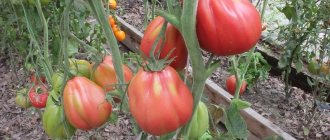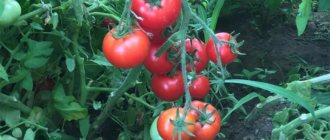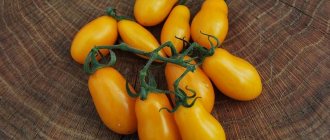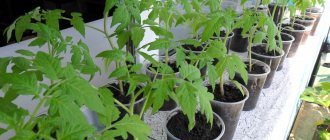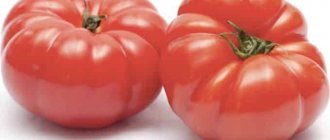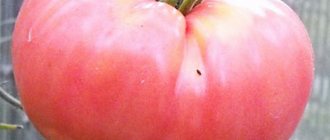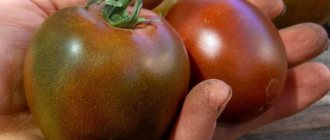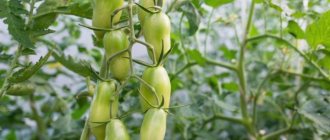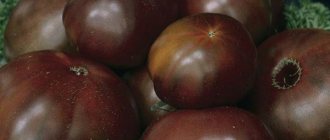General description of Mikado
The variety is represented by several varieties that differ in the color of the fruit. Among them there are both plants with classic red and pink berries, and more exotic ones - black-fruited tomatoes. For decades now, Mikado tomato seeds have been grown in different regions of our country.
Note! Mikado is a variety. Seeds from its fruits are used for planting. They are collected from berries ripened on the bush, washed to remove the pulp, dried and stored in clothing bags.
Tomato Mikado black
Distinctive features of the varieties
The main advantage of the variety is large fruits with a rich sweet taste and an abundance of pulp. Another advantage of such tomatoes is considered to be high immunity. Mikado is not afraid of most tomato diseases, including late blight.
The Mikado group includes several tomato varieties . They have similar characteristics and differ in the color of the fruit:
- Mikado is golden . Produces yellow fruits. Contains an increased concentration of beta-carotene and lycopene. Improves vision, speeds up metabolism and has antioxidant properties. Rarely cause allergies.
- Mikado pink . It has pink fruits that are high in vitamin C and selenium. Such berries help increase immunity and improve brain activity.
- Mikado red . Increased serotonin content. Improves mood, removes bad cholesterol and free radicals from the body.
- Mikado black . The fruits are burgundy in color with brown and dark purple spots. This color is due to the presence of anthocyanin. This is a strong antioxidant that not only removes harmful substances from the body, but also improves the condition of the heart and blood vessels.
Mikado also has some disadvantages . This variety is susceptible to temperature changes. If it is too hot outside, the fruits will crack. At low temperatures, plants simply stop growing.
Tomatoes 2021. Variety Mikado
Main characteristics
All varieties of Mikado have almost the same characteristics . Only the color of the fruit differs:
| Parameter | Indicators |
| Bush type | Indeterminate variety. The height varies between 1.5–2 m. In a greenhouse, plants turn out taller. The stems are thick and strong. The bushes are medium leafy. The dark green leaves are large, potato-type. The first inflorescence is formed in the axil of 8-9 leaves. |
| Growing method | Tomatoes of this variety are grown both in open and protected ground in central and southern Russia. In the northern regions, tomatoes are grown in greenhouses. |
| Productivity | Average. From 1 sq. m harvest up to 8 kg of berries. |
| Fruit | Large ones. The weight of one berry varies between 300–700 g. The shape is round, strongly flattened at the base. There is pronounced ribbing. The taste is rich, sweet, with barely noticeable sourness. There is a lot of pulp, it is juicy and tender. The variety is characterized by multi-chambered properties. The color of the berries depends on the type of variety. Available in pink, yellow, red and burgundy with dark Mikado spots. The color of the shell matches the color of the pulp. |
| Transportability | Low. Fruits are easily damaged during transportation. |
| Ripening time | Pink Mikado is an early ripening plant, its berries ripen 95–100 days after sowing the seeds. Black, golden and red Mikado are mid-season, their fruits ripen 110–115 days after sowing the seeds. Fruiting continues until the end of August. |
| Disease resistance | Has immunity to all tomato diseases. |
Tomato Mikado pink
Appearance of different Mikado tomatoes
The fruits of all varieties of Mikado tomato are so different in appearance that it is surprising to classify them as one variety. But their other characteristics (ripening period, height of the bush) are somewhat different. Often completely different varieties are closer in characteristics to each other than different types of Mikado. This once again raises doubts about the purity of the intentions of seed producers, that everything sold under the Mikado brand is precisely this variety.
Photo gallery: Mikado tomato varieties
Mikado pink - the founder of the series
The black variety often cracks
Mikado golden is very large-fruited
Mikado red is also very sweet
Growing seedlings
Mikado tomatoes are grown in seedlings . Otherwise, the fruits simply will not have time to ripen before the onset of cold weather.
The time for sowing seeds depends on the region and on the conditions in which they are going to be planted:
- in the southern regions, seedlings are sown at the end of February or early March;
- in the central zone - in the second half of March;
- in cities with cold climates - in early April.
If you plan to grow tomatoes in a greenhouse , the seeds are sown 14 days earlier. Experienced gardeners recommend checking the timing of work with the lunar calendar.
Mikada orange
This orange-fruited variety (not a hybrid) appeared thanks to the efforts of the Aelita agricultural company. It is not listed in the State Register. But gardeners speak very enthusiastically about its taste; this variety, according to many, is the sweetest. Intended for open ground in warm regions and for film shelters in cool regions. The ripening period is early - 85 - 100 days after the first complete shoots. According to the description of tomato growers, the tomato grows about 2 meters. The fruit cluster is of intermediate type, loose. There is a lot of ovary, but experienced gardeners recommend rationing it, leaving about 3 fruits. The color of ripe tomatoes is deep orange due to their high beta-carotene content. Care is carried out as usual.
Agricultural technology of Mikado tomatoes
Tomatoes are planted in open ground when the soil temperature at a depth of 15 cm reaches +16 °C . By this time, the age of the bushes should be from 55 to 60 days. Three days before planting, the plants are watered and fed - this will help cope with stress faster.
And more about tomatoes:
Tomato variety "Strawberry Tree"
Hybrid tomato "Bella Rosa"
Picking to a permanent place
Tomato is a light-loving plant. It is planted in the most illuminated area of the garden. Mikado is most sensitive to lack of light. In such conditions, it begins to hurt and does not set fruit.
Tomatoes should not be preceded by other nightshade crops . Choose areas of the garden where legumes or melons were previously cultivated. In autumn the soil is prepared. It is dug up to the depth of a spade bayonet and cleared of plant debris. Then add 4 kg of humus per 1 sq. m. If the acidity of the soil is increased, ash or dry lime is added to it. In spring, the beds are leveled with a rake and cleared of weeds.
The holes are dug in rows in a checkerboard pattern . For 1 sq. m place 3-4 plants. 1 tbsp is poured into the holes. l ash or dry granular long-acting fertilizers. Then 1 liter of water is poured into each recess.
The plant is placed in the hole along with a lump of earth. If the tomatoes were grown in peat pots or tablets, then the container is not removed when planting, but destroyed on several sides. After this, the bushes are covered with soil, which is compacted.
Tomato Mikado red
Basic rules of care
The Mikado tomato is tied to wooden supports or trellises with synthetic thread. Heavy fruits should also be attached to a support.
Form a plant into one or two stems . The more stems left, the smaller the fruits will be and the later the harvest will ripen. During the pinching process, it is important to remove leaves at the bottom of the stem, yellowed and wilted greenery. Do this once a week, getting rid of no more than three leaves in one procedure.
Water the plants as the soil dries out . The water should be settled and warm. If the liquid gets on the ground part of the bush, burns will appear on the leaves. After each watering, the soil is loosened - the formation of an earthen crust, which interferes with normal root air exchange, should not be allowed to form. During the loosening process, weeds are removed. Do this while the weeds are still green. Otherwise, the roots of the tomatoes will be damaged when weeding.
Feeding is applied four times per season . Alternate complex mineral and organic. Foliar fertilizers are applied twice. Use products containing boron. They will speed up the formation of ovaries.
Tomato Mikado black
What you need to know to get a good harvest
When growing tomatoes, it is important to follow the basic rules for caring for them. Gardeners should also familiarize themselves with the nuances that will help them get a bountiful harvest:
- On the day of planting, the tomatoes are not watered. Moistening the soil during this period will increase the likelihood of plant disease.
- Plant and water tomatoes when the sun is not active. The best time is early morning or evening.
- Tomato bushes are shaken regularly to stimulate pollination.
- To avoid wasting time moistening the soil, many gardeners install a drip irrigation system.
- Deformed inflorescences are removed. They produce low-quality fruits.
Diseases and pests
The Mikado variety has high immunity to major tomato diseases. He is not even afraid of late blight. However, it is worth following the rules of prevention :
- All garden tools that will come into contact with the beds are disinfected. Garden soil and greenhouse walls are also disinfected. Copper sulfate is used for this.
- To prevent diseases, tomatoes are sprayed with a light pink solution of potassium permanganate.
- To protect plants from small pests, plantings are sprayed with a decoction of celandine. Egg shells buried in holes help against mole crickets.
- Large beetles are collected by hand.
Further care of the variety
In order for the plant to develop normally and bear fruit abundantly, it needs to be properly cared for.
Watering rules
Before watering, you should check the soil moisture. The top layer, 5 centimeters thick, must be dry. Watering should be plentiful. Surface moisture harms the bushes.
It is important to avoid stagnation of fluid. Otherwise, there is a risk of developing late blight or root rot.
How to remove stepsons
It is recommended to remove stepchildren manually. It is not recommended to use scissors for this. In this case, it is worth removing stepsons larger than 3 centimeters. After the procedure, it is recommended to leave a stump measuring 1-1.5 centimeters. This will stop the emergence of a new stepson.
How to fertilize correctly
In the first half of summer, the crop needs organic fertilizers. Grass, mullein or chicken droppings are suitable for this. Infusions are prepared from these products and used for watering plants.
At the beginning of summer, nitrogen fertilizers are often used. It is best to use urea or ammonium nitrate. At the end of summer, such fertilizing is not recommended, since it negatively affects the ripening of fruits. During this period, phosphorus-potassium fertilizers are used.
The nuances of growing in open and closed ground
Tomato Mikado black
The Mikado tomato is grown in greenhouses and in open ground . There are several nuances that are important to consider when using these methods. In a greenhouse, diseases spread faster and there is increased humidity. Solving these problems is simple - regularly ventilate the room.
To speed up pollination , experienced gardeners recommend installing a fan in the greenhouse. The walls of the room must be treated with a disinfectant composition.
In open ground, the beds are watered 2-3 times a week , depending on weather conditions. The greenhouse requires only one watering.
After planting seedlings in open ground, for the first two weeks they are covered with film at night to protect the plants from frost.
Protection from diseases and pests
Bordeaux mixture is used to prevent fungal infection. The substance is treated with seedlings a week before planting in the soil. In dry and cool weather, you can do without chemicals. It is enough to sprinkle the tomatoes with a solution based on milk and water in a ratio of 1:10. It is also worth adding a few drops of iodine to the product.
If the first symptoms of late blight appear, it is worth using fungicides. Fitosporin is popular among summer residents. It is harmless to people and works well against fungi.
Advantages and disadvantages of the variety
Tomato Mikado black
Benefits of Mikado:
- large fruit;
- rich color palette of fruits;
- rich sweet taste;
- possibility of growing in open and protected ground;
- immunity to tomato diseases.
Disadvantages of the variety:
- the need for gartering and pinching;
- sensitivity to temperature changes;
- low transportability.
What does Mikado Pink look like?
Strengths and weaknesses of the variety
The advantages of these tomatoes include:
- precocity;
- high productivity;
- excellent taste;
- possibility of long-term storage;
- beautiful appearance.
Among the disadvantages, gardeners note:
- loss of taste during processing;
- demanding care;
- need for fertilizers;
- poor heat tolerance.
Farmer reviews
Feedback from farmers about Mikado tomatoes is mostly positive . The fruits of this variety are as large and beautiful as in the photo.
Irina, Sochi: “I’ve been growing Mikado for more than 10 years. I tried all varieties of this variety. I like the black ones best, as they are the sweetest. Golden Mikado is the most beautiful. A tomato rarely gets sick even when grown in open ground.”
Alexander, Ryazan: “Tomato Mikado is the most favorite variety. Loved because of its large and sweet fruits. The largest tomato of this variety that I managed to obtain weighed 680 g. I form the bushes into one stem, so the fruits are larger.”
Characteristics
“Mikado pink” produces large pink fruits – from 300 to 600 g. The peel and pulp are dense, which allows them to be stored and transported. The shape of the fruit is round, slightly flattened. The taste is sweet. According to the experience of housewives, when canning a tomato can change its taste and not for the better. Therefore, it is recommended to a greater extent for fresh consumption.
You can compare the weight of the fruits of this variety with others in the table below:
| Variety name | Fruit weight |
| Mikado Pink | 300-600 grams |
| Gypsy | 100-180 grams |
| Japanese truffle | 100-200 grams |
| Nobleman | 300-400 grams |
| Cosmonaut Volkov | 550-800 grams |
| Chocolate | 200-400 grams |
| Spasskaya Tower | 200-500 grams |
| Newbie pink | 120-200 grams |
| Palenque | 110-135 grams |
| Pink icicle | 80-110 grams |
Very tasty in salads, suitable for seasoning soups, making tomato paste, sauces and juice. For whole-fruit canning, you can use blanched or green fruits.
As for the yield of the variety, it is 10-12 kg per square meter, and you can compare it with the yield of other varieties in the table:
| Variety name | Productivity |
| Mikado Pink | 10-12 kg per square meter |
| Apples in the snow | 2.5 kg per bush |
| Samara | 11-13 kg per square meter |
| Yablonka Russia | 3-5 kg per bush |
| Valentina | 10-12 kg per square meter |
| Kate | 15 kg per square meter |
| Explosion | 3 kg per bush |
| Raspberry ringing | 18 kg per square meter |
| Yamal | 9-17 kg per square meter |
| Crystal | 9.5-12 kg per square meter |
We bring to your attention articles about high-yielding and disease-resistant tomato varieties. And also about tomatoes that are resistant to late blight and about effective methods of protection against this disease.
